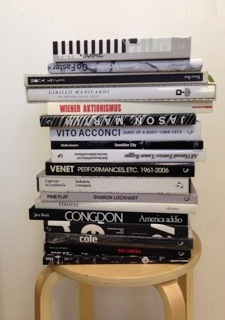Have you ever
wondered where rare architecture books – the ones that you can only find in the
vaults of Avery, the RIBA, the CCA, or the Getty; the ones that are preserved
in dark rooms with controlled temperature and humidity; the ones that are kept
close to the door so that they could be more easily pulled out in case of a
catastrophic event – come from?
Beinecke Rare Book & Manuscript Library, Design SOM/Gordon Bunshaft, 1963
Walter Gropius. Internationale Architektur. München: A. Langen, 1927.
Weinreb Architectural Collection, University of Texas
These precious items are collection objects, often exhibited behind glass. As such you will be required to use gloves and book cradles to handle them. They are being digitized - check for instance Il Primo Libro d'Architettura by Serlio at Columbia University Libraries on archive.org - which makes scholars' life much easier. These books are acquired by institutions or great collectors mainly to be admired, not read.
Beinecke Rare Book & Manuscript Library, Design SOM/Gordon Bunshaft, 1963
Internet-based retailers have completely changed the way books - both new and out of print - are sold, forcing bookstores like Rizzoli in New York, Hennessey + Ingalls in LA, Walther König in Köln, RIBA in London, the CCA in Montreal, Pro qm in Berlin, or Hochparterre in Zurich to open up to new activities that engage and "entertain" their clients: presentations, apéro with the author, small exhibitions. Here the book is also a social facilitator.
Do researchers and scholars still rely on university press catalogues? I certainly do, at least twice a year (Spring and Fall). They give you an overview of what others are working on. Content, content, content: these are the books that you can actually read, underline, use. They have notes, useful bibliographies and allow advancing the thinking. In this case the bookseller is of little help.
Photographs EF
But their business does not end here. Allow me to enter a grey zone and refer to display books: they are sold or rented by the meter according to specific stylistic characteristics.
An Italian Design furniture company that want be promote a new bookshelf at the Milano Design Week orders a hundred meters of art books, with 28-30 cm black-white-red spines. The books are ready in a week and cost eighty euros the meter.
A set designer orders twenty meters of historical books, with 22-24 cm beige spines, preferably Gallimard, for a photo shoot. The books are ready in a couple of days and transportation is by and paid by the customer.
Photographs EF
An esteemed lawyer sends the bookseller a photo of a corner office. The image shows an imperial desk, a leather armchair, a Persian carpet, a big window on the back, two plants and two libraries, one on each side of the window. The bookseller will provide sixteen meters of leather books for a perfectly symmetrical composition.
An elegant lady may orders ten meters of books with aubergine and silver spines, and other ten with sage spines to decorate the newly renovated living room.
A store may get forty meters but request that the bookseller rips the covers and exposes the bindings (it takes about fifty meters of books).
All these books are set up for purely decorative and representative purposes. They will never be open and will go to waste as soon as the event ends or they no longer serve the purpose.
Collection books, rare books, books that entertain, scholar's books, display books and their respective book dealers: it is a very interesting and diverse business, isn't it?








